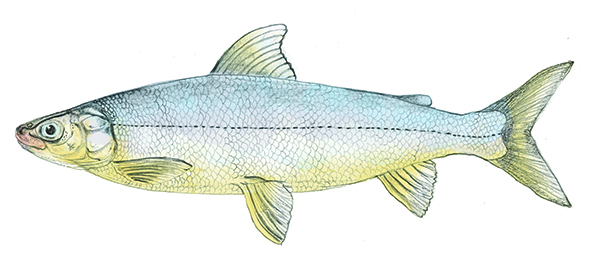Home → Fish & Wildlife → Fisheries → Species Information → Lake Whitefish
Lake Whitefish

Common Name: Lake Whitefish
Other Names: Whitefish
Scientific Name: Coregonus clupeaformis
Origin: Native
Adult Size: Whitefish are normally 14-20 inches long and weigh 1-3 pounds, but can reach lengths of 25 inches and over 6 pounds. A number of lakes contain populations of "dwarf" size fish where mature adult whitefish attain lengths of only 6-8 inches.
Identification: Overall coloration is silvery dark brown to black on the back, becoming silvery on the sides and silvery white below. The fins are generally black or black tipped. Scales are large. The body is somewhat laterally compressed. Lake whitefish are easily distinguished from fallfish (chub) by having a small mouth and the presence of a small adipose fin located on the back between the dorsal and caudal fins. A related species, the round whitefish is light brown on the back becoming silvery on the side. It has a more cylindrical body shape than the lake whitefish.
Diet: Lake whitefish feed primarily on zooplankton, midge larvae, and small crustaceans. As they grow larger, some whitefish feed on small smelts and other fish.
Fishing Tips: Whitefish are most effectively caught by fishing through the ice using small baited jigs. As the bulk of their food resides on or near the lake bottom during winter, most whitefish are caught in the lowest two to three feet of the water column. Water depths between 30 and 60 feet are usually the most productive. Vertical jigging during the open water fishing season can be an effective way to catch whitefish too, but results can vary and few anglers pursue whitefish this way. Probably the most challenging and uncommon way to catch whitefish is using small dry flies on the water surface during the short springtime period when whitefish are surface feeding.
Interesting Facts: Lake whitefish in Maine have much longer potential life spans than previously thought. Recent age analysis using sagittal otoliths (an inner ear bone) has shown whitefish in many populations living for 20-30 years. In one example, we found an 11-inch long whitefish that we estimated to be 43-45 years old.
Physical and biological characteristics of whitefish can vary widely from lake to lake – so much so, that reproductively isolated ‘dwarf’ forms of whitefish have emerged in several waters in northern Maine. These dwarf fish reach a very small size, mature earlier, and generally have a much shorter life span. Researchers from Quebec have been studying the differentiation between dwarf and normal whitefish in Maine for more than 30 years. It is believed that the emergence of dwarf whitefish represents a fascinating example of the formation of a new species, which can take advantage of an ecological niche within certain waters that normal lake whitefish do not occupy.
Management: Lake whitefish populations have suffered massive declines over the past 50 years or so. In a 2016 status assessment, the Department determined that whitefish remained present in about 50 waters in Maine, but many of those waters no longer supported self-sustaining populations, meaning we are likely to see continuing decline of the species, including complete loss of whitefish populations in a number of lakes.
Lake whitefish declines have coincided with the introduction of rainbow smelt, and research in Maine and elsewhere has identified smelt as the primary cause to reproductive failure and eventual loss of whitefish populations. A current research project within MDIFW is attempting to better understand the exact mechanisms that are driving the whitefish-smelt interaction, and find ways to mitigate the problems and inform whitefish recovery efforts.
Restrictive fishing regulations over the past two decades and a whitefish hatchery stocking program (from 2003-2009) appear to have helped in some waters, but have resulted in limited success to date. Recently we have seen very positive results in waters with increased numbers of lake trout, which have caused depressed smelt numbers. These low smelt numbers appear to have reduced the level of smelt-whitefish interaction and resulted in encouraging levels of whitefish reproduction.